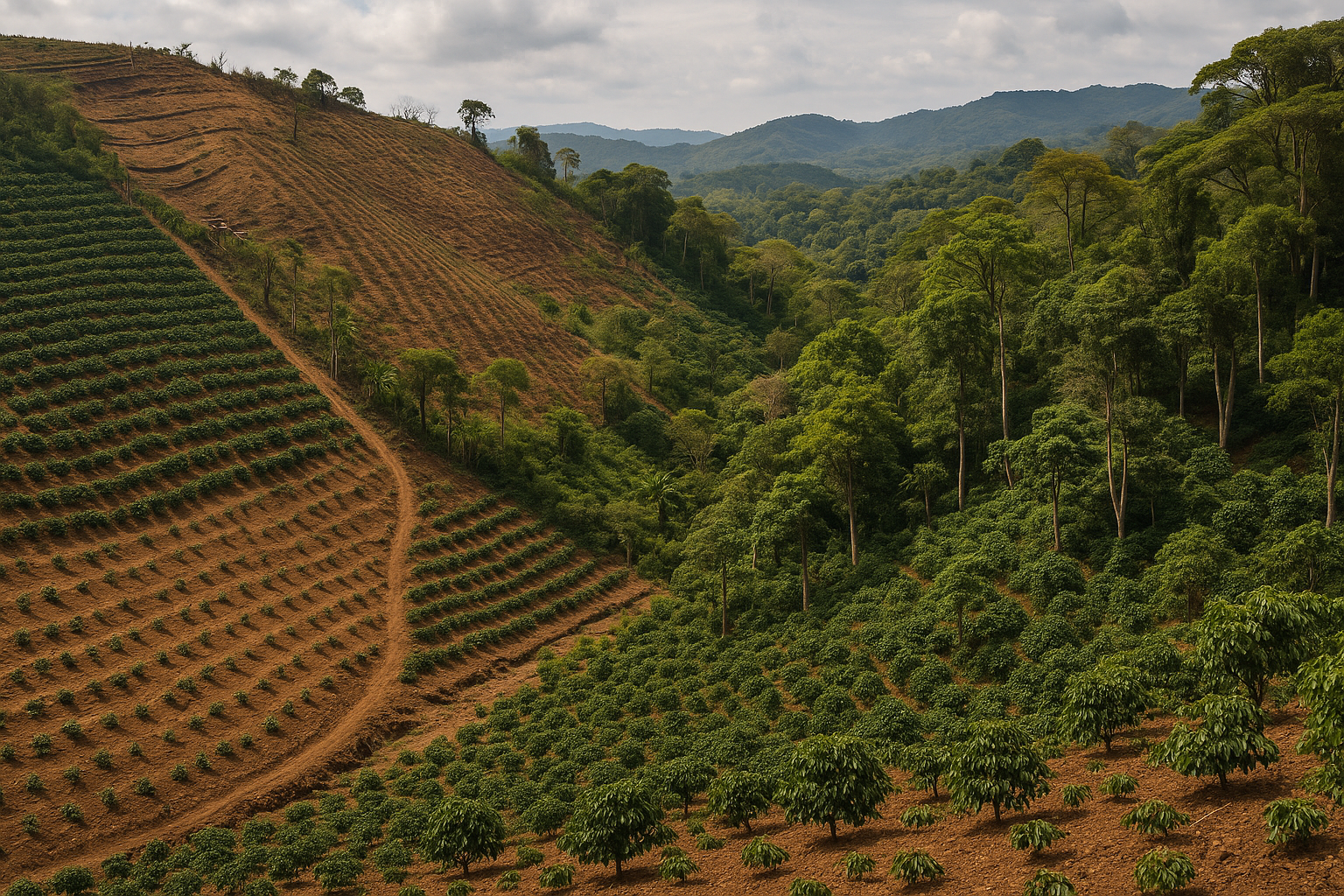Coffee is the second most traded commodity in the world, and its demand continues to grow. But behind the rich aroma and energizing sip lies an industry with a significant environmental cost—especially when conventional farming methods are involved.
While the coffee sector brings economic opportunity to many regions, it also contributes to deforestation, water pollution, and soil degradation.
In this article, we explore the true environmental cost of conventional coffee farming and why it’s crucial to shift toward more sustainable practices.
What Is Conventional Coffee Farming?
Conventional coffee farming typically refers to large-scale, intensive agriculture methods aimed at maximizing yield. These operations often rely on monoculture planting (growing only coffee plants), synthetic fertilizers, pesticides, and heavy irrigation.
Many of these farms are located in regions that were once rich in biodiversity—rainforests and mountainous ecosystems—cleared to make way for rows upon rows of coffee shrubs. While these methods are efficient for short-term production, the long-term consequences are often devastating to the environment.
Deforestation: The Hidden Price of Expansion
One of the most critical environmental issues linked to conventional coffee farming is deforestation. In the pursuit of higher yields and more farmland, forests are cleared, particularly in countries like Brazil, Vietnam, and Indonesia.
Removing native trees has severe consequences:
- Loss of wildlife habitats and biodiversity
- Disruption of local water cycles
- Increased greenhouse gas emissions
- Soil erosion and loss of fertility
Shade-grown coffee, once a natural norm, is often abandoned in favor of sun-grown monocultures that require more chemical input and degrade the land faster.
Soil Degradation and Erosion
Soil health is foundational for agriculture. Yet, in conventional coffee farming, intensive cultivation and chemical use degrade the very ground that sustains the plants.
Over time, synthetic fertilizers and pesticides strip the soil of organic matter and beneficial microorganisms. As the soil becomes less fertile, more chemicals are applied—creating a cycle of dependency that ultimately weakens the land.
In areas with sloped terrain, the absence of tree roots and vegetation makes farms more susceptible to erosion. Heavy rains can wash away nutrient-rich topsoil, reducing productivity and increasing sedimentation in rivers and lakes.
Water Pollution and Overuse
Water is essential to coffee production, not only for growing the plants but also for processing the beans after harvest. In conventional systems, this demand often leads to excessive water use and contamination of nearby water sources.
There are two major water-related issues in conventional coffee farming:
- Chemical Runoff: Pesticides and fertilizers used on coffee farms frequently enter rivers and groundwater. This runoff can harm aquatic ecosystems and pose risks to human health.
- Wet Processing Waste: In the “wet method” of coffee processing, significant amounts of water are used to remove the fruit from the beans. The wastewater, often full of organic material, can ferment and pollute waterways if not properly treated.
Pesticides and Their Ecological Impact
To fend off pests and increase yields, conventional farms use a variety of chemical pesticides. While effective in the short term, these substances can harm non-target species, including bees, birds, and beneficial insects.
Moreover, prolonged exposure to pesticides creates “super pests”—insects that develop resistance, requiring even stronger chemicals. This arms race damages ecosystems and further degrades soil and water.
There are also human consequences. Farmworkers are often exposed to dangerous levels of these chemicals, especially in countries with weak labor protections or limited access to protective gear.
Climate Change and Carbon Footprint
Ironically, conventional coffee farming contributes to the very issue that threatens its future: climate change. The carbon footprint of conventional coffee includes:
- Deforestation emissions
- Use of fossil fuel–based fertilizers
- Energy-intensive processing methods
- Long-distance transportation and packaging waste
As the climate warms, coffee-growing regions face increased risks of drought, pests, and crop failure. Conventional farming methods are not only contributors to these problems—they are also less equipped to adapt.
Biodiversity Loss on a Massive Scale
Coffee farms built on monocultures do more than just damage soil—they eliminate the natural diversity that once thrived in those ecosystems. Birds, insects, mammals, and plants lose their habitats when forests are cleared and single-species farming takes over.
In contrast, traditional shade-grown coffee farms often coexist with biodiversity. Trees offer shelter to birds and insects, creating a natural balance that controls pests without synthetic inputs.
By pushing biodiversity out of the equation, conventional farming leaves crops more vulnerable to disease and environmental instability.
The Social and Environmental Interconnection
Environmental degradation doesn’t occur in a vacuum. The ecological consequences of conventional farming ripple through nearby communities:
- Contaminated water affects local health
- Soil erosion reduces food security for nearby farmers
- Deforestation increases landslide and flood risks
In many coffee-producing countries, indigenous communities and smallholder farmers suffer most when large operations exploit natural resources irresponsibly. Sustainability isn’t just an ecological issue—it’s a human rights issue.
Is Conventional Farming the Only Option?
Absolutely not. There are numerous alternatives to the conventional model:
- Organic farming avoids synthetic chemicals, improves soil health, and supports biodiversity.
- Agroforestry systems reintroduce trees into coffee farms, mimicking natural ecosystems.
- Regenerative agriculture focuses on restoring degraded land while producing crops.
While these methods may have lower yields in the short term, they offer long-term resilience, improved quality, and ecosystem restoration. With consumer demand and institutional support, sustainable models can and should become the new standard.
What Role Do Consumers Play?
You have more influence than you think. Every bag of coffee you buy supports a set of farming practices. Choosing sustainable, certified coffee means voting for:
- Soil and water conservation
- Reforestation and wildlife protection
- Fair labor and community investment
- Climate-resilient agriculture
Look for certifications such as Organic, Rainforest Alliance, or Fair Trade. Even better, buy from roasters who provide detailed sourcing information and support regenerative practices.
Government and Industry Responsibility
Although individual action matters, large-scale change requires policy and corporate accountability. Governments should:
- Enforce regulations against illegal deforestation
- Support farmers in transitioning to sustainable methods
- Provide education and subsidies for eco-friendly practices
Meanwhile, coffee companies must adopt transparent sourcing standards, invest in sustainability research, and reduce their environmental footprints across supply chains.
The Cost of Inaction
If conventional coffee farming continues unchecked, the consequences will be profound:
- Entire ecosystems could collapse
- Coffee-growing regions may become uninhabitable
- Farmers will face increased poverty and displacement
- Consumers could see rising prices and declining quality
The time to act is now. Transforming coffee production into a sustainable system is not just possible—it’s essential for the future of agriculture, biodiversity, and global climate stability.
Final Reflections: Brewing a Better Future
Your daily cup of coffee has more impact than you might think. While conventional farming has powered global coffee production for decades, it’s time to question its cost. The environmental price is too high, and the planet can’t afford to pay it much longer.
We can change this story. By supporting sustainable farming, advocating for policy reform, and making conscious choices, we can protect both the environment and the communities who grow the coffee we love.
The journey to sustainable coffee starts with awareness—and continues with action. The next time you brew a cup, let it be a reminder that even small habits, repeated daily, can shape a healthier, more sustainable world.

